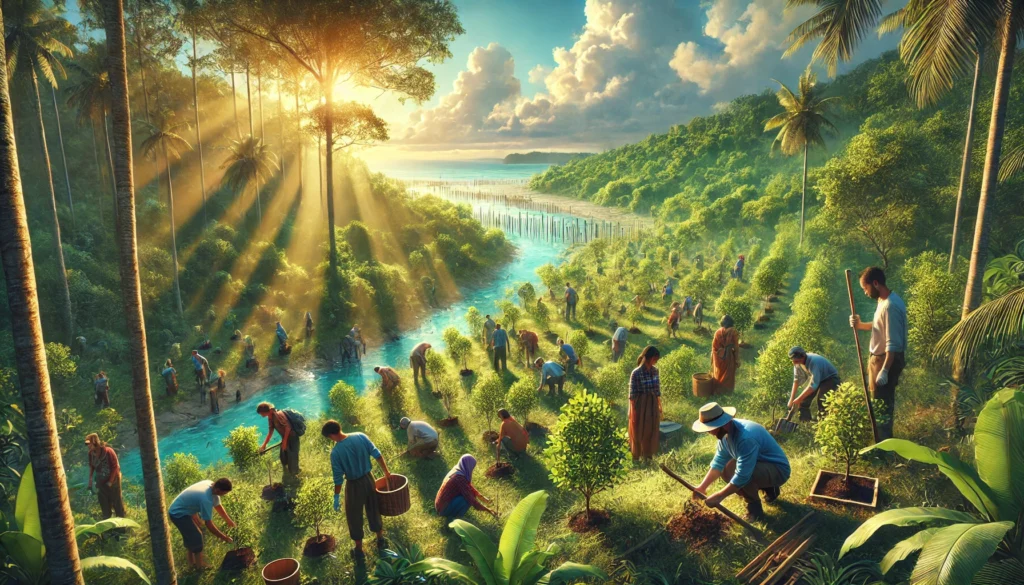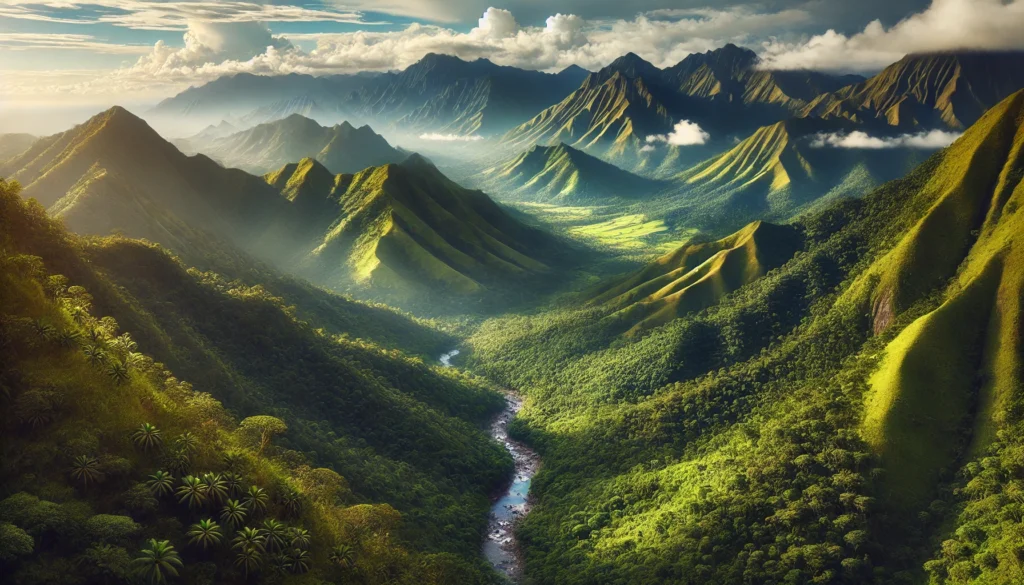Let’s face it, folks: our planet is in a bit of a pickle. Climate change, deforestation, and biodiversity loss are knocking on our door like persistent salespeople trying to hawk their wares. But fear not! There’s a superhero in town, and it goes by the name of Community-Based Conservation (CBC). Now, before you roll your eyes and think, “Great, another conservation buzzword,” hear me out. CBC isn’t just another fancy term cooked up by eco-warriors in their treehouse meetings. It’s a game-changer that’s empowering local communities to take charge of their environment and natural resources. So, grab your metaphorical cape, and let’s dive into the world of CBC – where everyday people become the heroes our planet desperately needs.
The ABCs of CBC: What’s the Big Deal?
Definition and Core Principles
Alright, let’s start with the basics. Community-Based Conservation is like that group project in school where everyone actually pulls their weight (shocking, I know). It’s an approach to conservation that puts local communities at the center of decision-making and management of natural resources. Imagine if instead of some suit-wearing bureaucrat telling you how to manage your backyard, you and your neighbors got together and decided, “Hey, let’s turn this into a thriving ecosystem that benefits all of us!” That’s CBC in a nutshell.
The core principles of CBC are like the ingredients in your grandma’s secret recipe – each one crucial to the overall success:
- Local participation: This isn’t a spectator sport, folks. Everyone gets to play!
- Empowerment: Giving communities the tools and authority to make decisions. It’s like handing over the TV remote, but for nature.
- Sustainable use: Using resources wisely, so there’s enough for future generations. Think of it as not eating all the cookies in one sitting.
- Knowledge integration: Blending traditional wisdom with scientific know-how. It’s like a nature-themed fusion restaurant.
- Economic benefits: Because saving the planet should also help pay the bills.
The Evolution of CBC: From Underdog to Top Dog
Historical Context
Once upon a time, in a galaxy not so far away (actually, right here on Earth), conservation was all about fencing off areas and keeping people out. It was like putting nature in a museum – look, but don’t touch! This approach, while well-intentioned, had about as much success as trying to herd cats. Local communities, who had been managing these resources for generations, were suddenly told, “Hands off!” Unsurprisingly, this didn’t go over well.
Enter CBC, stage left. This approach recognized that maybe, just maybe, the people who had been living in harmony with nature for centuries might know a thing or two about conservation. It was a revolutionary idea, kind of like realizing that your grandma’s home remedies actually work better than some over-the-counter medications.
The concept of CBC started gaining traction in the 1980s and 1990s. It was like the conservation world collectively slapped its forehead and said, “Duh! Why didn’t we think of this before?” Since then, CBC has been growing faster than a weed in a well-fertilized garden, spreading across continents and ecosystems.
The Good, The Bad, and The Ugly: CBC Success Stories and Challenges
Success Stories
Now, let’s talk about some CBC rockstars that are hitting conservation out of the park:
- The Namibian Conservancy Program: Picture this – a country where wildlife populations are increasing, local communities are benefiting economically, and poaching is down. No, it’s not a fairy tale; it’s Namibia! Their community conservancy program has been so successful that other countries are looking at it like a kid eyeing the last piece of cake.
- Nepal’s Community Forestry: Nepal took deforestation, looked it straight in the eye, and said, “Not today, buddy!” By empowering local communities to manage their forests, they’ve seen forest cover increase and poverty decrease. It’s like killing two birds with one stone, except no birds were harmed in this conservation success story.
- Philippines’ Coastal Resource Management: The Philippines said “enough is enough” to overfishing and coral reef destruction. By involving local fisherfolk in management decisions, they’ve seen fish populations bounce back faster than a rubber ball. It’s proof that when you give people a stake in conservation, they’ll rise to the occasion like dough in a warm kitchen.
Challenges and Criticisms
Now, before we get too carried away singing CBC’s praises, let’s acknowledge that it’s not all sunshine and rainbows. CBC faces more challenges than a contestant on a reality TV show:
- Power dynamics: Sometimes, the loudest voices in the community drown out the rest. It’s like that one friend who always decides where to eat.
- Capacity building: Teaching new skills can be as challenging as explaining memes to your grandparents.
- Balancing conservation and development: It’s a tightrope walk that would make even the most skilled acrobat nervous.
- Sustainability of funding: Because, unfortunately, money doesn’t grow on the trees we’re trying to save.
- Measuring success: Quantifying conservation success can be trickier than nailing jelly to a wall.
The Science Behind the Magic: How CBC Actually Works
Ecological Benefits
Now, let’s get our nerd glasses on and look at the science behind CBC. Ecologically speaking, CBC is like giving nature a helping hand, or more accurately, thousands of helping hands. When local communities are involved in conservation, magical things start happening:
- Biodiversity bonanza: Species start thriving like they’re at an all-you-can-eat buffet of perfect habitats.
- Ecosystem restoration: Degraded areas start healing faster than a kid’s scraped knee.
- Sustainable resource use: It turns out, when people feel ownership, they’re less likely to over-exploit. Who knew?
Let’s look at some data that’ll make your inner science geek do a happy dance:
| Ecological Indicator | Before CBC | After CBC Implementation |
|---|---|---|
| Species Diversity | Low | High |
| Habitat Quality | Poor | Improved |
| Resource Depletion | Rapid | Slowed or Reversed |
| Ecosystem Resilience | Low | High |
Social and Economic Impacts
But wait, there’s more! CBC isn’t just about hugging trees and saving cute animals (although that’s a delightful bonus). It’s also about improving people’s lives. Here’s how:
- Economic empowerment: Conservation can be a cash cow (figuratively speaking, of course).
- Improved livelihoods: When nature thrives, people thrive. It’s a beautiful symbiosis.
- Cultural preservation: Traditional knowledge gets the respect it deserves.
- Conflict resolution: Turns out, working together for a common goal can make people forget why they were fighting in the first place.
Let’s throw some numbers at you:
| Social/Economic Indicator | Before CBC | After CBC Implementation |
|---|---|---|
| Poverty Rates | High | Decreased |
| Community Conflicts | Frequent | Reduced |
| Cultural Practices | Declining | Revived |
| Local Empowerment | Low | High |
CBC Around the Globe: A World Tour of Conservation Awesomeness
Africa: Where CBC Roars
Africa, the cradle of humanity, is also the cradle of some kick-butt CBC initiatives. Let’s take a safari through some of the continent’s conservation highlights:
- Kenya’s Conservancies: Picture this – Maasai warriors trading their spears for binoculars and becoming wildlife guardians. It’s not a movie plot; it’s reality in Kenya’s community conservancies. These areas are like Noah’s Arks on land, protecting wildlife while also benefiting local communities. The result? Wildlife populations are up, poaching is down, and tourists are flocking in like it’s a Black Friday sale at a Kenyan mall.
- Zimbabwe’s CAMPFIRE Program: No, this isn’t about roasting marshmallows (although that sounds delightful). CAMPFIRE (Communal Areas Management Programme for Indigenous Resources) is all about giving rural communities the right to manage and benefit from their wildlife. It’s like turning every villager into a mini wildlife CEO. The program has its ups and downs, but it’s shown that when people see wildlife as an asset rather than a nuisance, magical things happen.
Asia: Conservation with a Side of Spice
Moving east, Asia is serving up some conservation dishes that are hotter than a bowl of extra-spicy curry:
- India’s Tiger Reserves: India said, “Hold my chai,” and showed the world how involving local communities can turn the tide for endangered species. By creating buffer zones around tiger reserves and involving local communities in conservation and ecotourism, India has seen its tiger population roar back from the brink. It’s like a Bollywood comeback story, but with more stripes and whiskers.
- Indonesia’s Coral Triangle Initiative: In the world’s epicenter of marine biodiversity, local communities are diving in (literally and figuratively) to protect their coral reefs. It’s like an underwater neighborhood watch program, but instead of keeping an eye out for suspicious characters, they’re guarding against destructive fishing practices and climate change impacts.
Latin America: Conservation Salsa
Let’s cha-cha our way to Latin America, where CBC initiatives are as vibrant as a carnival parade:
- Costa Rica’s Community-Based Tourism: Costa Rica looked at its lush forests and thought, “Why not turn this into a eco-friendly cash cow?” By empowering local communities to run ecotourism projects, they’ve created a win-win situation where tourists get authentic experiences, forests stay intact, and local people benefit economically. It’s like having your tres leches cake and eating it too!
- Brazil’s Extractive Reserves: In the Amazon, local communities have been given the right to sustainably extract forest products like rubber and nuts. It’s turned poachers into protectors faster than you can say “açaí bowl.” These reserves are proof that you can use natural resources without abusing them – a concept as refreshing as a caipirinha on a hot day.
The Future of CBC: Crystal Ball Gazing
Emerging Trends and Innovations
Alright, let’s put on our futurist hats and peer into the crystal ball of conservation. What does the future hold for CBC? Spoiler alert: it’s looking brighter than a firefly disco!
- Technology Integration: Imagine local communities using drones to monitor wildlife or smartphone apps to track illegal logging. It’s not science fiction; it’s the future of CBC. Technology is empowering communities to be the eyes and ears of conservation efforts, like a global network of eco-spies (but way cooler and totally legal).
- Market-Based Approaches: The future of CBC might involve more innovative financing mechanisms. Carbon credits, payments for ecosystem services, and conservation-friendly products could turn protecting nature into a lucrative business. It’s like turning conservation into a profitable venture – Captain Planet meets Warren Buffett!
- Climate Change Adaptation: As climate change continues to throw curveballs at us, CBC will likely play a crucial role in helping communities adapt. Local knowledge combined with scientific predictions could create resilience strategies that are more effective than a sunscreen with SPF 1000.
- Urban CBC: Who says CBC is just for rural areas? The future might see more community-led conservation efforts in cities. Urban gardens, community-managed parks, and citizen science projects could turn concrete jungles into actual jungles (well, sort of).
Potential Challenges and Solutions
Of course, the road to conservation utopia isn’t without its potholes. Here are some challenges we might face and how we could tackle them:
- Scaling Up: How do we take successful small-scale projects and apply them more broadly without losing that local touch? It’s like trying to franchise your grandma’s secret recipe – tricky, but not impossible. Solution: Creating networks of CBC initiatives to share knowledge and resources, kind of like a conservation version of social media (but with less cat videos and more actual cats).
- Balancing Traditional and Modern Approaches: As technology advances, how do we ensure we don’t lose valuable traditional knowledge? Solution: Creating platforms where elders and youth can exchange knowledge, like a cultural exchange program but within the same community.
- Navigating Global Politics: With increasing global interconnectedness, local conservation efforts might face pressures from international policies or markets. Solution: Strengthening local governance systems and advocating for policies that protect community rights. It’s like giving local communities a seat at the global dinner table.
- Maintaining Long-term Engagement: How do we keep communities motivated for the long haul, especially when results aren’t immediate? Solution: Developing long-term benefit-sharing mechanisms and celebrating small wins along the way. Think of it as a marathon with snack stations and cheerleaders throughout the course.
Your Turn to Join the CBC Party!
Well, folks, we’ve traveled the globe, dived into success stories, faced challenges head-on, and even gazed into the future. By now, you’re probably thinking, “This CBC stuff sounds amazing! How can I get in on this action?” Fear not, dear reader, for I have some actionable steps for you:
- Get Informed: Learn about CBC initiatives in your area. Knowledge is power, and in this case, it’s also conservation!
- Volunteer: Many CBC projects welcome volunteers. It’s a chance to get your hands dirty (sometimes literally) and make a difference.
- Support Local: Buy products from community conservation initiatives. Your purchase could be supporting both livelihoods and ecosystems.
- Spread the Word: Become a CBC ambassador. Share success stories on social media, bore your friends with conservation facts at parties – whatever it takes!
- Think Globally, Act Locally: Start or join local environmental initiatives. Remember, every great movement starts with a single step (preferably in a direction away from environmental destruction).
Community-Based Conservation isn’t just a fancy term or a passing fad. It’s a powerful approach that’s reshaping how we think about and practice conservation. By putting local communities at the heart of conservation efforts, we’re not just saving ecosystems; we’re empowering people, preserving cultures, and creating a more sustainable future for all.
So, the next time you hear about a CBC project, don’t just nod and say, “That’s nice.” Get involved! Because in the story of saving our planet, you’re not just an extra – you’re a potential lead actor. Now, go forth and conserve, my friends! The Earth is counting on you (no pressure, though).
Disclaimer: This blog post is based on information available up to 2020. While we strive for accuracy, conservation is a dynamic field with constantly evolving practices and data. Please refer to current sources for the most up-to-date information. If you spot any inaccuracies, let us know – we’re always eager to learn and improve, just like a well-managed CBC project!




